
- Aug 21, 2025
Namibia’s Exports Analysis: Trends, Products, and Global Trade Insights
Over the past few years, Namibia's exports have played a vital role in driving economic recovery and growth, especially after the setbacks caused by the global pandemic.
As per Namibia Import Data by Import Globals, the export of natural resources like diamonds, uranium, copper, and fish is a major part of Namibia's economy, which is well-known for its enormous deserts, mineral wealth, and thriving marine ecosystem. It has established itself as a major trading partner in Southern Africa thanks to its advantageous port facilities on the Atlantic coast and stable political climate.
As per Namibia Export Data by Import Globals, the country's export portfolio is dominated by mining and fisheries, with value-added industries still in the nascent stages. As global demand shifts and new markets emerge, Namibia continues to explore diversification opportunities while strengthening trade ties with countries like South Africa, Botswana, China, and various European nations.
General Economic Indicators of Namibia
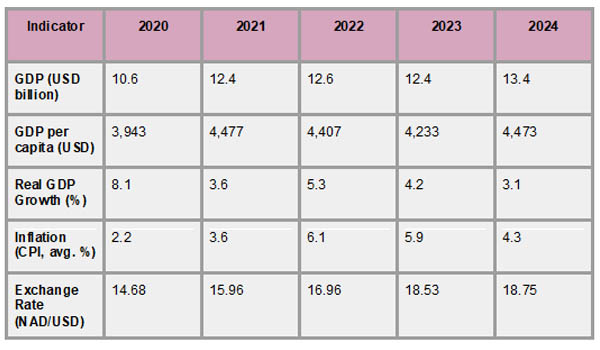
After the global pandemic-related depression in 2020, Namibia's economy has shown resilience and a slow comeback. As per Namibia Import Export Trade Data by Import Globals, after declining by 8.1% in 2020, the country's GDP grew by 3.5% in 2021 and 4.6% in 2022. The economy grew 3.2% in 2023, and forecasts for 2024 indicate a growth rate of 4.6%. Improvements in population dynamics and economic productivity have led to a slight increase in GDP per capita, which reached about USD 4,743 in 2023.
As per Namibia Import Custom Data by Import Globals, the average annual inflation rate for the period from November 2023 to October 2024 is projected to be 4.6%, indicating that inflation has stayed comparatively steady. However, the unemployment rate continues to be a major worry. It dropped to 19.1% in 2024 after reaching a peak of 36.9% in 2023. The fiscal balance improved from -2.1% of GDP in 2022 to an expected -1.6% in 2023, indicating a shrinking deficit. With the debt-to-GDP ratio falling from 69.8% in 2022 to 66.7% in 2024, public debt levels have leveled off. Over the last six months, the Namibian dollar has fluctuated in value relative to the US dollar, averaging NAD 18.49 per USD.
Namibia's Export Product Categories
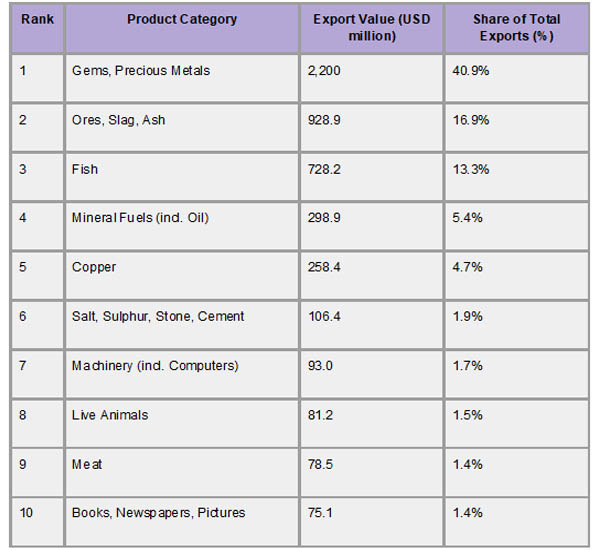
Namibia's abundant natural resources, especially in the mining and fishing industries, are a major contributor to the country's export economy. The nation's premium diamonds, which are the main source of its export earnings, are well-known across the world. In addition to diamonds, uranium, copper, zinc, and lead are important mineral exports. As per Namibia Import Trade Analysis by Import Globals, the need for industrial minerals has grown globally, so too has the export of ores, slag, and ash in recent years. With fish and seafood, particularly hake and horse mackerel, ranking among the top export goods, the nation's marine resources are also extremely important.
Namibia also diversifies its export base by exporting smaller but increasing amounts of agricultural goods like meat, live animals, and salt. As per Namibia Import Data by Import Globals, the low export percentage of manufactured products and machinery highlights the nation's low level of industrialization. Namibia's export-heavy portfolio makes it susceptible to changes in the price of commodities globally. To create a more resilient and diversified economy over time, however, initiatives are being made to increase value-added output and grow the non-mineral export industries.
Namibia's Export Values
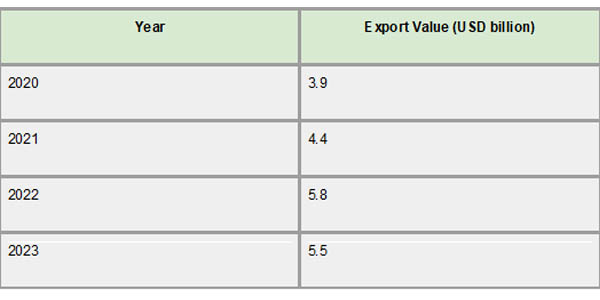
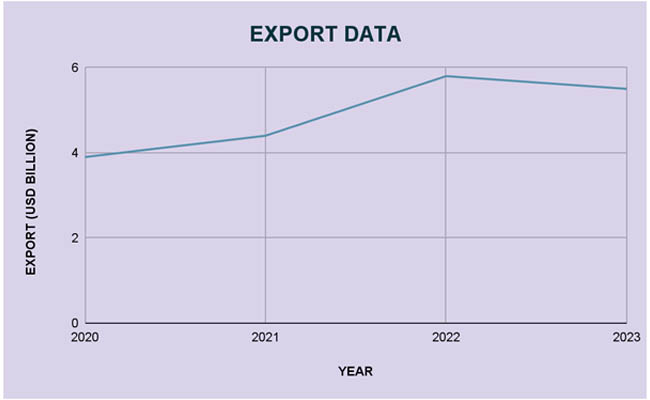
The global economy and the dynamics of the commodity market have had a significant impact on Namibia's export performance over the last five years. Exports totaling about USD 3.9 billion were recorded in 2020, indicating the effect of the worldwide epidemic on trade. As per Namibia Import Trade Statistics by Import Globals, with exports rising to USD 4.4 billion in 2021, a 14.2% yearly growth, the next year saw a turnaround. This upward trend continued into 2022, with exports reaching USD 5.8 billion, representing a significant 31.9% increase from the previous year. However, due to some variables, including changes in the worldwide market and currency fluctuations, exports somewhat decreased to USD 5.5 billion in 2023, a 5.8% fall.
It is projected that export values will rise in 2024 due to rising demand for Namibia's main commodities, including fish products, uranium, and diamonds. It is anticipated that initiatives to improve value addition in the mining and fishing industries and diversify export markets will improve export performance. Furthermore, as per Namibia Import Shipment Data by Import Globals, Namibia's position in the global export market is intended to be strengthened by smart trade alliances and infrastructure improvements. To maintain and improve export growth in the upcoming years, aggressive policy initiatives and ongoing observation of global economic trends will be essential.
Major Export Destinations
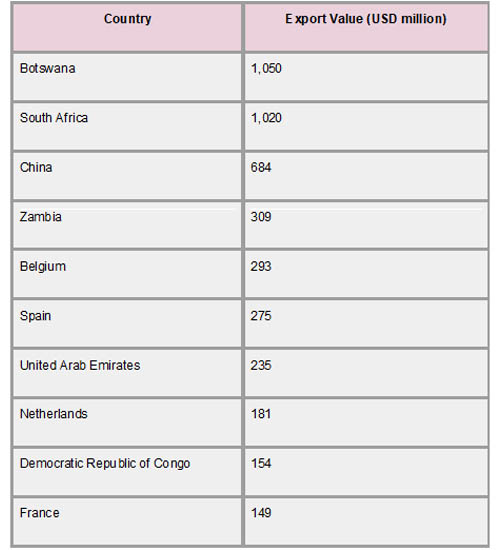

Namibia's export environment in 2023 was primarily influenced by its trading connections with important international markets and its neighbors. As per Namibia Import Export Trade Analysis by Import Globals, approximately USD 1.05 billion, or 19.3% of Namibia's total exports, went to Botswana, making it the country's top export destination. As per Namibia Export Import Global Trade Data by Import Globals, South Africa, which absorbed 18.6% of exports, or USD 1.02 billion, came in second. With USD 684 million in imports, or 12.4% of Namibia's total exports, China was the third-largest market. Spain (USD 275 million), Belgium (USD 293 million), and Zambia (USD 309 million) were other important destinations, each of which contributed 5% to 6% of the overall export value.
These top trading partners collectively accounted for a substantial portion of Namibia's export revenue, highlighting the country's reliance on both regional and international markets. The export portfolio to these nations was dominated by minerals such as diamonds, uranium, and copper, along with fish products. Notably, in November 2023, China temporarily became Namibia's leading export destination, reflecting the dynamic nature of global trade flows and the importance of diversifying export markets.
Forecast Trend
As per Namibia Import Export Global Data, with a cautiously positive prognosis for Namibia's economy, the Bank of Namibia projects a 3.8% GDP growth in 2025, up from an estimated 3.7% in 2024. The main drivers of this projected increase include predicted advancements in uranium production, crop farming, and the expansion of the water and energy subsectors. With more investments from the public and private sectors, the secondary industries, such as manufacturing and construction, are also expected to rise. However, these estimates are at risk from issues including probable disruptions due to climate change and tensions in global trade.
Namibia's exports are anticipated to recover in 2025, especially in the uranium industry, which is anticipated to expand by 7.5% as a result of ongoing demand worldwide. On the other hand, due to persistent difficulties in the worldwide market, the diamond mining industry is predicted to shrink by 6.2% in 2025. After contracting in 2024 as a result of the severe drought, the agriculture industry is expected to rise by 2.4% in 2025, marking a moderate recovery. All things considered, even while the export environment offers growth prospects, it is nonetheless vulnerable to changes in the external market and environmental conditions.
Conclusion
Namibia's export-driven economy continues to evolve, powered by its abundant natural resources and strategic trade partnerships. While diamonds, uranium, and fish remain the pillars of its export portfolio, efforts toward diversification and value addition are slowly gaining momentum. The country’s economic recovery post-pandemic has been steady, with promising forecasts for growth in key sectors. However, challenges such as high unemployment, global market volatility, and climate vulnerabilities underscore the need for resilient economic planning. Moving forward, sustained investment in infrastructure, regional integration, and policy reforms will be essential to strengthen Namibia’s position in the global trade landscape.
If you are looking for detailed and up-to-date Namibia Export Data, You Can Contact Import Globals.
FAQs
Que. What are Namibia's top export products?
Ans. Namibia's top export products include diamonds, uranium, copper, fish (especially hake and horse mackerel), and other minerals like zinc and lead. These resources form the backbone of the country’s export economy.
Que. Which countries are the main destinations for Namibia’s exports?
Ans. Namibia exports primarily to Botswana, South Africa, China, Zambia, Belgium, and Spain. These countries account for the majority of Namibia’s export revenue, with diamonds and fish being key traded commodities.
Que. How has Namibia’s export performance evolved from 2020 to 2024?
Ans. Namibia’s exports were valued at around USD 3.9 billion in 2020 and peaked at approximately USD 5.8 billion in 2022. There was a slight decline in 2023, but exports are expected to recover by 2025 due to strong demand for uranium and other resources.
Que. Where to obtain detailed Namibia Import Data?
Ans. Visit www.importglobals.com or email info@importglobals.com for more information on up-to-date Namibia Import Data.
